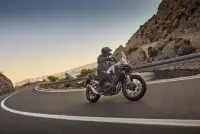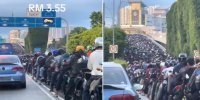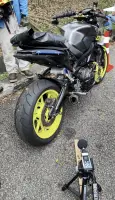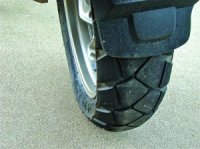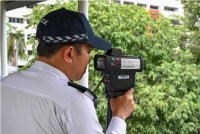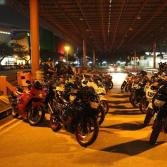.thumb.jpg.942d9c8d2090d78b3319f3cc3d3744e6.jpg)
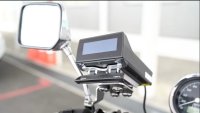
Early adopters who had installed their processing unit on the passenger side can opt to switch it over to the driver’s side for free, says the Minister for Transport.
For motorcycles, the OBU components - a processing unit, an antenna and a touchscreen display - are integrated into a single unit. (Photo: CNA/Hanidah Amin)
SINGAPORE: The one-piece ERP 2.0 on-board unit (OBU) used for motorcycles cannot be used for cars, as the “greenhouse effect” within a car can make it too hot for such a device to be placed on the dashboard.
On Wednesday (May 😎 in parliament, Minister for Transport Chee Hong Tat explained the rationale for cars requiring a three-piece OBU. Issues related to the device, including its multiple parts and placement within the vehicle, have caused considerable consternation among motorists.
Specifically, Mr Chee was responding to a question by Member of Parliament Lim Wee Kiak (PAP-Sembawang), who had asked why a one-piece OBU could not be used for both motorcycles and cars.
“If you think about the physics of it, in an enclosed environment with glass, it is like a greenhouse … which will cause the interior of the car in an enclosed space to be warmer,” replied Mr Chee.
He said tests had shown it was "quite clear" that both footwells - driver and passenger - experienced significantly lower temperatures than that of the dashboard on a sunny day.
“The ambient temperature: If it's about 35 degrees - for the motorcycle, (it) is pretty much that because it's not an enclosed space,” said Mr Chee.
For the footwell of a car, he added, temperatures can go up to 38 to 39 degrees Celsius and on the dashboard, as high as 50 to 52 degrees Celsius.
“With this kind of temperature, if you were to put a single-piece OBU, which means the antenna, the display, and the processing unit all on the dashboard, there is a risk that it could overheat, and then it will affect the functionality of this unit,” he said.
A cooling fan could be incorporated into the OBU's design, but this would make the system very bulky.
“I don't think motorists will want a very big and bulky one piece unit on their dashboard. It would not be the right design,” he said.
Mr Chee added that early adopters who had installed their processing unit on the passenger side could opt to switch it over to the driver’s side without charge.
“I think that is fair because when they installed earlier, they were not given an option,” said Mr Chee. “But if some of them now want to do it, we will offer this reconfiguration for them free of charge.”
"NECESSARY TRADE-OFF"
Mr Chee also responded to another question by Dr Lim on the installation of the processing unit at the driver's footwell ever since the Land Transport Authority made it clear last week it was an option.
The processing unit holds payment cards, also known as CEPAS cards, such as the NETS FlashPay card, NETS Motoring Card and EZ-Link Motoring Card, which drivers use to pay for electronic road pricing or parking charges.
Dr Lim referenced a CNA article citing concerns by car mechanics that installing the processing unit at the driver's footwell may also come with its own set of complications.
Referring to the article, Mr Chee agreed with the assessment of the mechanics.
“It's not so straightforward for all vehicle makes and models, because depending on the design and the layout and specifications of different vehicles, the preferred location, the ideal location (of the processing unit) may vary from vehicle to vehicle,” he said.
LTA recommends installing the ERP 2.0 processing unit at either the driver’s or the front passenger’s footwell. (Photos: LTA)
He added that the compromise for having choices was more complexity in the installation process.
“But we think this trade-off is important because we do need to respect the individual choices of vehicle owners,” he said.
The Transport Minister said he is among the 18,000 motorists who have installed the OBU in their vehicles so far.
He too, like many early adopters, had concerns about reaching his payment card conveniently if he had to use complimentary parking tickets.
“That's why I was very happy when LTA developed that feature where I could just deactivate the card by pressing a button on the touchscreen display,” Mr Chee said. “Now I can do that very conveniently, I do not need to take my card in and out.”
SMARTPHONE CANNOT REPLACE ENTIRE OBU
Replacing the whole OBU with a smartphone is not feasible because usage-based charging requires the device to be attached to the car, said Mr Chee, responding to a question by Workers’ Party MP Gerald Giam (Aljunied).
A smartphone is “something that you carry with you; it's not secured to the vehicle”, said Mr Chee.
For the purposes of ERP - whether distance- or usage-based - a device needs to be secured to the vehicle “so that you know where the vehicle is, and there's no dispute about whether the device is functioning or not”.
He added that smartphones would not be able to provide the same level of data and systems security as the current OBU. However, using smartphones as a device for displaying information would be feasible.
“We have studied that option and we are going to allow people to opt out of (using the OBU touchscreen) and to use a smartphone or their in-vehicle display if they wish to,” said Mr Chee.
Article Credits: CNA
Join SingaporeBikes on Telegram for more of the latest news, special offers, reviews of motorcycles, and more!
- Read more...
-
- 0 comments
- 1,222 views
.png.f357c4bbda45b8d1f0301390a48a7ff4.png)

